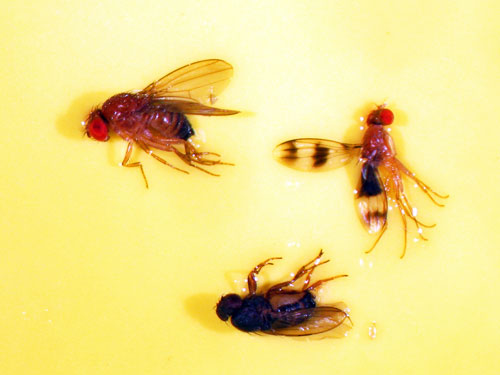Blueberry Insect Scouting Report for May 28-June 3, 2012
We have our first captures of spotted wing Drosophila for 2012.
Crop stages
As of June 1 in Van Buren County, blueberries of all varieties appeared to be sizing rapidly. The situation is similar in Ottawa County, and Bluecrop, Rubel, Blueray and Jersey are at mid-green fruit, while Elliot was at small green fruit.
Weekly insect pest report
Cherry fruitworm moth flight is over at all the farms we visit in Van Buren County and flight should end this week in Ottawa County. Similarly, egglaying by cherry fruitworm is expected to end in the next few days at the sites we are scouting.
Windy, cool and rainy weather over the last week contributed to low captures of cranberry fruitworms in traps. However, we expect flight to continue for at least another week to 10 days in Van Buren County and at least two weeks in Ottawa County. According to the MSU Enviro-weather model for cranberry fruitworm, on June 1, egglaying by cranberry fruitworms was predicted to be 84 percent complete in Grand Junction, Mich. (first moth capture May 5), and 69 percent complete in West Olive, Mich. (first capture May 11). The cranberry fruitworm model on Enviro-weather can be used to see when cranberry fruitworm egglaying is expected to decrease in your area. Growers and scouts can remove cherry fruitworm traps from fields. A detailed article about fruitworm management has been posted at the MSU Extension Fruit News website.
The number and size of blueberry aphid colonies has remained consistent over the past week at all the farms we visited. The percentage of shoots that are infested with blueberry aphid is still high in some spots (0 to 35 percent) at the farms we visit. Although natural enemies can keep this pest in check, aphids can transmit blueberry shoestring virus, so growers may want to consider using an insecticide to control aphids if there are blueberry varieties that are susceptible to shoestring on the farm. Insecticides that are toxic to bees should not be used for aphid control where bees are still present. See theBlueberry Facts website or this previous article from the June 8, 2010, Blueberry IPM Newsletter for more information on aphids.
The first spotted wing Drosophila (SWD) of the 2012 season were trapped last week at two berry farms, one in Allegan County and one in Ottawa County. These captures were all female flies and are about a month earlier than the first capture in 2011. The flies were found in traps baited with yeast (three flies) and apple cider vinegar (one fly). Photo 1 shows a female SWD detected last week (top left), along with two other species that are not SWD. This highlights the need to be able to identify this pest accurately.

First detections of a female SWD fly (top left)
captured in a yeast-sugar baited
trap in late May 2012. Also shown are two
other fly species captured in traps.
This first capture of SWD is an important early warning for growers of blueberries, raspberries and cherries that are the most susceptible fruit crops. With strawberries currently ripe, it would also be worth monitoring this crop for SWD. Traps for SWD should be out now to identify the timing of activity at fields where this pest is present. This will help growers make plans for managing SWD when fruit is at risk. The flies cannot infest fruit until it starts to turn color, so unripe fields do not yet need to be treated for this pest. For more information on how to monitor and control this new pest, see the MSU Spotted Wing Drosophila website, and the updated blueberry management guide with the latest control recommendations. MSU will host a workshop next Tuesday, June 12, in Fennville, Mich., at the Trevor Nichols Research Center to cover the monitoring, identification and management of SWD. See the registration information.
Blueberry maggot traps should also be hung this week. First emergence of blueberry maggot flies often occurs after a heavy rain or after irrigation in the middle of June. With the warmer than usual year and large populations last year, we expect blueberry maggot emergence to be earlier. The warmer regions of southwest Michigan are currently at or approaching the number of degree days that predict first emergence of blueberry maggot (913 degree days, base 50). For more information on monitoring and controlling blueberry maggot, see the Blueberry Facts website or a previous article in the June 21, 2011, Blueberry IPM Newsletter.
Dr. Isaacs' work is funded in part by MSU’s AgBioResearch.



 Print
Print Email
Email


